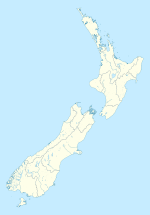Cape Egmont | |
|---|---|
 Cape Egmont Lighthouse with Mount Taranaki in the background | |
 | |
| Location | 39°16′46″S 173°45′07″E / 39.279385°S 173.752004°E |
| Offshore water bodies | North Taranaki Bight, South Taranaki Bight |
Cape Egmont, splitting Northern and Southern Taranaki Bights, is the westernmost point of Taranaki, on the west coast of New Zealand's North Island.[1] It is located close to the volcanic cone of Mount Taranaki or Mount Egmont.
It was named Kaap Pieter Boreel by Dutch explorer Abel Tasman in 1642, but renamed Cape Egmont by British explorer James Cook in 1769. (Note: Tasman did not sight Mount Taranaki, due to bad visibility, but Cook did, and after naming the mountain Mount Egmont, bestowed the same name on the promontory, which became the enduring name). Ironically, the cape retained a Dutch name, as Cook named the mountain and cape after the Earl of Egmont, who claimed descent of the Dutch House of Egmond.
In July 1862, Kapoaiaia near Cape Egmont was the site of a hui between 600 members of Taranaki, Ngāti Ruanui, Ngā Rauru and Whanganui Māori iwi, discussing the First Taranaki War (1860–1861). There, it was agreed that the lands East and West of New Plymouth (Tataraimaka, Kaipopo, Waitaha and Waitara) were Māori lands, and that any attempt by European settlers to create a road south of Waireka Hill would be considered an act of war.[2]
The Cape Egmont Lighthouse was originally constructed on Mana Island near Porirua but was relocated to Cape Egmont in 1877.
- ^ "Place name detail: Cape Egmont". New Zealand Gazetteer. New Zealand Geographic Board. Retrieved 25 March 2010.
- ^ Prickett, Nigel (2008). "The Military Engagement at Katikara, Taranaki, 4 June 1863". Records of the Auckland Museum. 45: 5–41. ISSN 1174-9202. JSTOR 42905898. Wikidata Q58623361.
